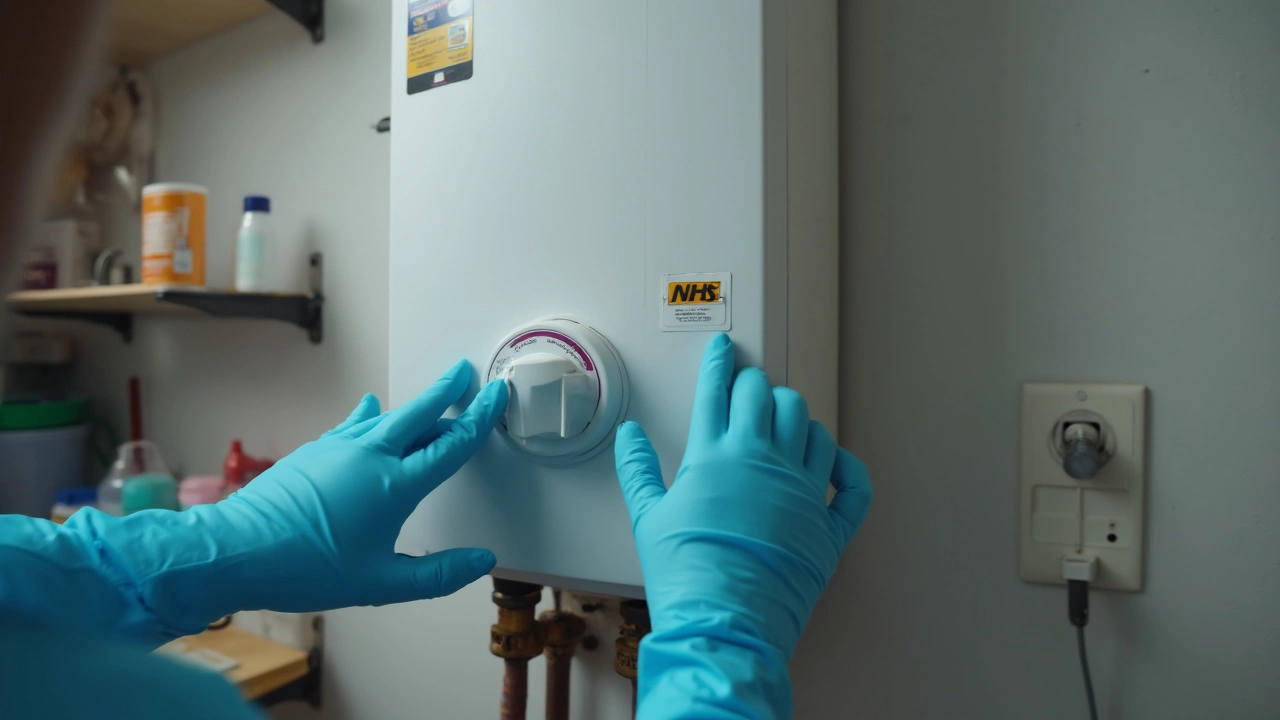Waking up to a lukewarm shower can ruin your morning fast. Nobody wants to mess with a broken water heater, but most of the time, you can figure out what’s wrong without much drama. Start by checking if it’s even getting power. For electric heaters, look at the breaker box—sometimes the breaker just trips. With gas units, make sure the pilot light’s burning. If you hear nothing but silence and see no flame, that’s your cue to dig deeper.
Take a quick look around your heater. Leaks? Pools of water? Any weird noises like popping or banging? These clues point straight to where the problem might be. If you’re dealing with rusty water, your heater’s probably rusting out on the inside. That’s not just a bummer; it means the whole tank might need replacing soon.
- Signs Your Water Heater is Failing
- Common Causes (and Easy Fixes)
- When to Try DIY and When to Call for Help
- Safety First—What Not to Touch
- Prevention and Long-Term Care
Signs Your Water Heater is Failing
You usually don’t realize how much you rely on hot water until you’re standing there shivering. Spotting early warning signs saves you headaches (and repair bills) down the road. Some of these signs are hard to miss, while others are sneaky. Here’s what to watch out for:
- water heater not working at all—no hot water comes out, no matter how long you run the tap.
- Water temperature keeps dropping or is just lukewarm, even when you crank it up.
- Strange noises like popping, crackling, or knocking from the tank.
- Rusty or dirty-looking water coming from your hot tap.
- Leaks or puddles pooling under or around the heater.
- Hot water runs out way faster than it used to.
When you hear your water heater groan, hiss, or make weird thudding noises, it usually means sediment is building up inside the tank. That stuff makes it work harder, which can wear it out faster. According to the U.S. Department of Energy, “Flushing your water heater once a year helps prevent sediment buildup and extends unit life.”
"Don’t ignore hot water that runs out faster than it used to. That’s often the first thing homeowners notice before a total failure." — American Home Shield
Rust stains in your sinks or tubs are another red flag that your tank’s on its last legs. A burst tank is rare, but leaky heaters are super common and can quietly destroy floors and walls. Here’s a table showing the most common failure signs and what percentage of heaters experience them before breaking down:
| Failure Sign | % of Heaters Reporting This |
|---|---|
| No hot water | 40% |
| Strange noises | 27% |
| Leaks or puddles | 22% |
| Rusty water | 8% |
| Fast hot water loss | 3% |
Noticing more than one of these symptoms? That’s your hint to act sooner rather than later. You might catch a small problem before it turns into an even bigger (and more expensive) mess.
Common Causes (and Easy Fixes)
Most of the time, when your water heater not working becomes an issue, it’s something basic tripping you up. Power problems lead the list. With electric models, a blown fuse or tripped breaker is usually the culprit. Head to your breaker box and reset it—sometimes that’s all it takes. Gas heaters need a steady pilot light. If it’s out, relighting it per your model’s instructions often solves things. Don’t forget to check the gas supply valve meanwhile. Sounds obvious, but I’ve done it—turned it off when moving boxes and forgotten to flip it back.
Another common headache: the thermostat. If you’re only getting lukewarm water, chances are your thermostat’s set too low or has given up completely. Bumping up the temp to around 120°F usually does the trick. Any higher, and you risk scalding.
Heating elements go out after a few years, especially if your home has hard water. If you own a multimeter, you can test them yourself, but swapping out a broken one is usually pretty cheap. On gas models, a bad thermocouple—a safety gadget that shuts off gas if it doesn’t detect a flame—leaves you with a cold tank. Replacing it takes less than half an hour and costs less than a pizza.
- No hot water, period? Power, gas, or a totally shot heating element is usually to blame.
- Strange noises? Mineral buildup at the bottom. Draining and flushing the tank at least once a year keeps it quiet and working better.
- Puddle under the tank? Often a loose valve or connection. Tighten with a wrench. If the tank itself leaks, though, you’re probably looking at a replacement.
Here’s a quick look at some of the most common problems and what usually fixes them:
| Problem | Likely Cause | Quick Fix |
|---|---|---|
| No hot water | Tripped breaker, blown fuse, pilot light out, faulty element | Check power/gas, reset breaker, replace element or relight pilot |
| Water too cold | Thermostat set low, faulty thermostat, element half-working | Turn up/set thermostat to 120°F, replace thermostat |
| Weird noises | Mineral buildup, sediment | Drain/fluh tank |
| Water leaks | Loose valves, rusted tank | Tighten valves or call for a new tank |
The Department of Energy says that water heaters over 10 years old are much more likely to act up, so if you’re constantly fixing yours, keep that in mind. These steps usually solve the most basic water heater issues and can save you a call to the pros.

When to Try DIY and When to Call for Help
Knowing what you can fix—and when to throw in the towel—can save you time, stress, and cash. Here’s the scoop: if your water heater’s problem is something simple like a tripped breaker (for electric models) or a blown-out pilot light (for gas heaters), you’re probably safe handling it yourself. Flipping a breaker or re-lighting a pilot only takes a few minutes, and there’s plenty of clear how-to videos online. Just be sure to cut power or gas before tinkering.
Other easy wins? Try adjusting the thermostat if the water’s not hot enough. If your problem is just sediment build-up causing popping or rumbling noises, draining a few gallons from the tank often solves it. Opening the drain valve at the bottom and letting some water out into a bucket is pretty basic stuff. Check your user manual for exact steps.
But if you spot signs of trouble like water leaking from the base, rust in your hot water, or a persistent rotten egg smell, don’t mess around—it’s time for a pro. Leaks can mean the tank’s corroded and could burst. Gas leaks or strange electrical issues are downright dangerous unless you know exactly what you’re doing. Folks who’ve tried to fix wiring mistakes or gas problems themselves usually end up with bigger repairs or risk hurting themselves.
Here’s a clear breakdown for when to try DIY and when to call in a professional:
- DIY: Resetting the breaker, relighting the pilot, turning up the thermostat, draining sediment.
- Call for Help: Water pooling at the base, rusty or weird-smelling water, unresponsive thermostat, error codes, gas leaks, electrical burning smells, or if you hear loud banging even after flushing out sediment.
If you ignore warning signs, a busted water heater not working right can quickly take out the whole tank and cause water damage. Plumbers deal with this stuff every day—so if you’re unsure, call one before you get in over your head.
Safety First—What Not to Touch
Messing with a water heater not working can be risky if you don’t know what you’re doing. Electric water heaters use 240 volts—enough to give you a nasty shock or worse. Gas heaters bring their own risks too, with carbon monoxide and fire if things go sideways. If you’re not sure what you’re looking at, stay on the safe side and don’t try to take things apart.
There are certain parts just not worth poking at if you’re not a pro:
- Wiring/Terminals: These carry high voltage. Unless the unit is shut off and you’re comfortable with electrical work, leave these alone.
- Gas valves and pilot assembly: One wrong move can lead to a gas leak. Smell gas? Get out of the house and call your utility provider—don’t try to fix it.
- Pressure relief valve: It might look like a simple handle, but it’s there to keep your heater from exploding. Don't tamper with it if you’re unsure what it does.
- Hot water connections: Pipes can be scalding hot even if the heater is off. Give them time to cool down before touching.
A survey from the National Fire Protection Association found that water heaters are involved in almost 10% of all accidental home water heating fires each year. Safety isn’t just a rule—it’s a stat-backed reality.
| Part | Hazard | What To Do Instead |
|---|---|---|
| Electrical Wires | Electric shock | Shut power; call a pro if in doubt |
| Gas Components | Gas leak, fire risk | Don’t touch if you smell gas |
| Relief Valve | Hot water, pressure release | Only test with clear instructions |
| Hot Pipes | Burns | Wait until fully cool |
If you ever feel uncomfortable, don’t risk it. When I called a local plumber the last time our heater started making weird noises, he told me, “The scariest calls are always when someone tried to fix it themselves first.” Save yourself the hassle—and maybe your eyebrows—and play it safe.

Prevention and Long-Term Care
Keeping your water heater in good shape doesn’t take much, but it saves you from cold showers and sudden breakdowns. Here’s the deal—most heaters last about 8–12 years if you treat them right. Regular attention prevents you from waking up one day with no hot water.
First, drain and flush your tank once a year. Sediment builds up no matter where you live, and when it settles, it makes your heater work harder and wear out faster. Hook up a hose to the drain valve, turn off the power or gas, and run out a few gallons till it’s clear.
Next up: check the anode rod. This piece attracts rust so your tank doesn’t have to. If it looks thin or coated in crud after a couple of years, swap it for a new one. You don’t need fancy tools—just a wrench and some patience. A good anode rod can double your heater’s life if you keep tabs on it.
Take a look at your temperature setting, too. Many people crank it up past 140°F, but there’s no need. At 120°F, you get plenty of hot water, lower energy bills, and less risk of scalding somebody by mistake.
- Flush the tank yearly to get rid of sediment.
- Replace the anode rod every few years, especially if your water’s hard or smells funny.
- Inspect for leaks or corrosion around pipes and fittings once a month.
- Test the pressure relief valve—just lift the lever and make sure water flows out, then resets easily.
If you ever see a puddle under the tank or hear new noises, don’t put it off. Small issues with your water heater not working can turn expensive fast. Write the install date somewhere you won’t forget, so you know when it’s time to think about a replacement before trouble starts. Regular checkups work better than last-minute panic repairs—trust me, I’ve learned the hard way. Simple routines go a long way.


